

© Shipping Wonders of the World 2012-

The Mersey Ferries
Some of the most efficient ferries in Great Britain, if not in Europe, ply across the River Mersey with a regularity that even fog rarely disturbs. The vehicular ferries linking Liverpool with the Cheshire shore are of a type rarely seen elsewhere
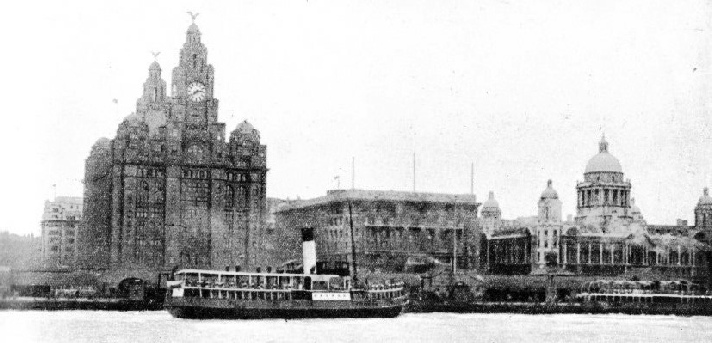
PIER HEAD, LIVERPOOL, is the focal point of the Mersey ferries, which ply from Princes Landing Stage to points on the opposite bank. The white-
THE distinctive feature of the Port of Liverpool is the River Mersey. The Mersey is not comparable in any way with the Thames or with the Clyde at Glasgow. The Mersey is a broad, deep stream which divides the Port of Liverpool into two disconnected components. At its narrowest point in the Port area, between Pier Head, Liverpool, and Woodside, Birkenhead, the river is just under a mile wide.
Between this point and the entrance to the Manchester Ship Canal at Eastham, six miles upstream, the Mersey is from two to three miles wide, and continues thus for a further six miles. Towards the estuary the river maintains a width of about two miles.
Thus even at its narrowest point the river could scarcely be bridged. The Lancashire and Cheshire banks are separated, for a distance of more than fifteen miles, by a great natural barrier. The steady waters of the Thames are a millpond compared to the Mersey at its calmest. In rough weather the turbulent waters assemble their forces into heavy waves whose pace is
accelerated by the strong, fierce tides which race past the immutable stone dock walls.
This, too, is right in the heart of one of Great Britain’s largest industrial areas. On the Lancashire side is Liverpool itself. On the opposite bank are ranged the towns of Birkenhead and Wallasey, with neighbouring townships or districts such as New Brighton, Rock Ferry and Port Sunlight.
The daily necessity for thousands of people and vehicles to pass from one side to the other has given rise to one of the greatest feats of modern engineering, Queensway, that great subaqueous tunnel connecting Liverpool and Birkenhead. There is another tunnel, at its inception no mean achievement of engineering skill, which carries an electric railway (the Mersey Railway) beneath the mighty river. Until recently, however, the majority of transport, passenger and vehicular, crossed the river in sturdy ferry boats which were, and still are, unrivalled in Great Britain.
Thus Merseyside can offer a form of travel which is unique in the country. Towns which, though divided by a great natural barrier, form one economic unit for all their parochial pride and rivalry, are welded together by fleets of powerful and efficient vessels which maintain exemplary and regular services that many railways would have difficulty in rivalling.
The focal point of the Mersey ferries is the Princes Landing Stage, off Pier Head, Liverpool. At the northern end of this floating stage berth transatlantic liners. At the southern end, under the shadow of the Liver Building and the Cunard White Star offices, the ferries berth in regular succession. Between the two extremes, river ferry and ocean liner, berth the smart packets on the Isle of Man and Irish cross-
The Mersey ferry fleets are controlled by two municipal bodies, the Wallasey Corporation and the Birkenhead Corporation. The Birkenhead fleet, red-
The Rock Ferry vessels serve an almost entirely residential area and there is no justification there for a goods service. To Woodside, however, there is a regular goods and vehicular service which, until the opening of the new Mersey Tunnel in 1934, provided the only means of vehicular transport between Liverpool and Birkenhead.
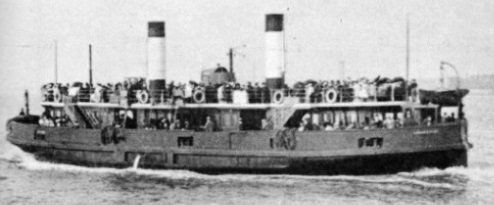
TWIN SCREWS FORE AND AFT propelled the Snowdrop and her sister, the Crocus, which were the first screw-
The white-
Among all the types of shipping, therefore, that may be seen every day in the Mersey, the fast and expeditious ferries are conspicuous. Conversely, to a passenger in one of the ferries the shipping is conspicuous. On the way to the office, the shipping clerk or the shop assistant may see from the deck of his “water-
From the earliest days, however, there was some form of ferry service. As early as 1332, Edward III granted a Charter to the Prior and Convent of Birkenhead “that they and their successors for ever might have the passage over the Arm of the Sea, as well for men as for horses and other things whatsoever, and might receive for that passage as might be reasonably done, without molestation or hindrance”.
First Steam Ferries
The security which the Prior must have felt with this charter, however, was rudely broken by Henry VIII in 1545 after the Dissolution of the Monasteries. The ferry rights were handed over to one of the monarch’s friends, and in 1626 the ferry was leased for a number of years to the Corporation of London.
Except as the final stages of a journey from North Wales and Chester to Liverpool, the ferry was of little importance, for the population of Birkenhead at that time was only a few hundreds. The ferry rights, however, were undoubtedly important, for it seemed inevitable that the ferries would some day develop into an important monopoly. The rights passed through various hands, often after embittered litigation. In 1842, however, the perpetual rights were bought by the Birkenhead Improvement Commissioners. Birkenhead became a borough in 1877, and twenty years later the Birkenhead Corporation bought the Rock Ferry and the New Ferry from private owners.
Meanwhile, the Wallasey ferries were undergoing a similar period of gradual change through the centuries. The earliest record of a ferry at Wallasey is in 1396. During the eighteenth century, however, there appears to have been little attempt to maintain a regular service. An important advance was made in 1835 by the building of a stone slip at Seacombe, and an even more far-
With the introduction of steam the Mersey ferries began to acquire an importance of their own. The first steam ferry was introduced in 1817. Named the Etna, she was designed by George la French, the Danish lessee of a hotel in Birkenhead. The Etna was apparently nothing more than two flats decked-
In 1822 the usual type of twin-
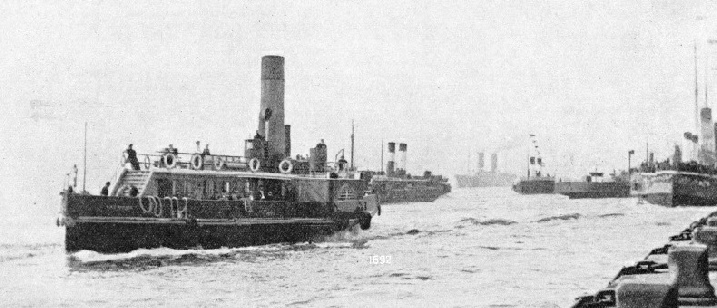
EARLY TWENTIETH-
Vessels of about 150 tons gross, these primitive steamers had nothing resembling a superstructure except for the bridge which spanned the deck amidships across the paddle-
Apart from the Birkenhead and Wallasey ferries, other ferries sprang into being from time to time during the nineteenth century. Some of these, particularly the Tranmere ferry (Tranmere is now incorporated in the municipality of Birkenhead), became serious competitors of the original ferries.
Among the most interesting of these ferries was the Eastham ferry. This started in almost the same way as the New Brighton ferry. Eastham was developed as a pleasure resort by the Eastham Ferry Pleasure Gardens and Hotel Company Ltd.
This company operated a service between Liverpool and Eastham, and acquired a considerable fleet of paddle steamers. At Liverpool the Eastham vessels were given a berth at the southern end of the Princes Landing Stage. Typical of these vessels was the Sapphire, built at Liverpool in
1898. She was a paddle steamer of 223 tons gross, 140 feet long, with a beam of 24 ft. 1 in. and a depth of 8 ft. 1 in.
About 1860 considerable improvement was shown in the design of the Mersey ferry boats. The Wallasey ferries acquired the Gem, a vessel of moderate freeboard, with no masts and one funnel abaft the paddles. The Gem figured in the most serious accident that ever has occurred to a Mersey ferry. On November 26, 1878, she left Seacombe at about 9.30 a.m., with about 250 passengers on board. There was a dense fog.
Funnel Knocked Over
Anyone who is acquainted with the power of the Mersey tide and the effect of a Mersey fog can imagine how this light craft would be swept through the swirling white curtains of fog. The flood tide carried the Gem across the bows of Brocklebank’s sailing vessel Bowfell, which was anchored in midriver. The ferry fouled the Bowfell’s bowsprit, which knocked over the funnel.
The sudden appearance of the sailing ship’s bows and the smash of the funnel on deck must have caused a panic among the passengers. Many people were pushed overboard and fifteen lives were lost, but the Gem was undamaged below the water-
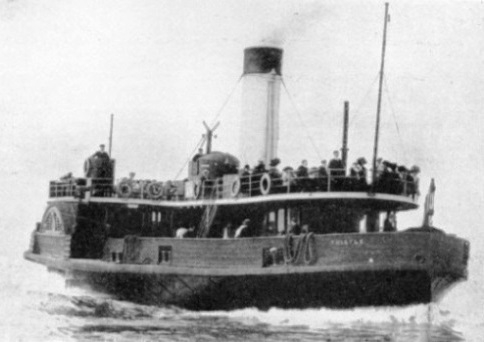
A REVERSION TO PADDLES was made in the Thistle, built at Kinghorn, Fife, Scotland, in 1891, because the screw-
Three newer and larger vessels joined the Wallasey ferries in 1862-
These vessels were the first Wallasey boats to have any form of saloon on deck, but the Birkenhead ferry produced the first real saloon boat in 1864. The Cheshire, as she was called, was the prototype of the present vessels on the Mersey ferries, except that she had two funnels placed athwartships.
In the following year the Heatherbell was put on the Seacombe service. A vessel of 205 tons gross, she had two funnels, one forward and one aft of the paddle-
By 1876 the volume of traffic had increased so much that it became necessary to rebuild Seacombe landing stage and to acquire three more vessels. The Sunflower, 242 tons, the Daisy and the Primrose, 285 tons, were built in 1879 at Glasgow. Their hulls were divided into watertight compartments and they carried nearly 1,000 passengers each. The Daisy remained in service until 1910.
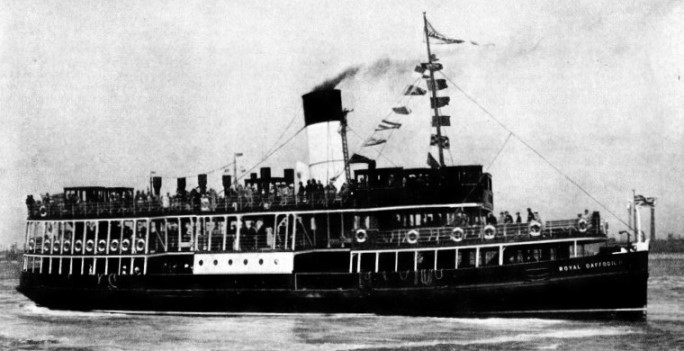
A THREE-
A well-
The first screw-
The Thistle, another paddle steamer, built in 1891, proved to be much faster. Two similar vessels, therefore, with raked funnel and mast, succeeded the Thistle. These were the 332-
The opening of the twentieth century was marked by the introduction of the modern type of vessel, which, with normal modifications and improvements, exists to-
In 1906 two new vessels entered the service, the Iris and the Daffodil, of 491 and 482 tons gross respectively. These were the vessels that twelve years later played an important part in the action at Zeebrugge, thus winning undying fame. For many years they continued to serve the Wallasey ferries, with the word Royal prefixed to their original names. The Royal Daffodil was sold to the New Medway Steam Packet Company. The Royal Iris was bought by the owners of the Rose.
The John Joyce and the Snowdrop, built in 1910, were still in service in 1936. Of 439 tons gross, they have a length of 152 ft. 3 in., a beam of 38 ft. 7 in. and a depth of 10 ft. 11 in. They have a draught of 7 ft. 6 in. and carry more than 1,500 passengers. A comparison of the cost of these vessels and of the cost of the next pair, built in 1921, bears witness to the influence of the war of 1914-
Fuel Economies
The Wallasey and the Marlowe were added to the Wallasey ferries passenger fleet in 1927. Their length is 151 ft. 5 in., their beam 48 ft. 1 in., their depth 14 ft. 6 in. and their draught 10 feet. They are the largest vessels of the 1936 fleet, with a gross tonnage of 606 and a passenger capacity of 2,223.
These dimensions give a key to the unusual features of these vessels. Their length was limited to 152 feet by statute, and to give increased accommodation the beam had to be made as large as possible. This gave rise to the problem of designing such a vessel so that her manoeuvring and steering capacity would not be impaired. Instead of having propellers fore and aft, as had formerly been the practice, Captain Fry, who was responsible for the design, specified the Flettner system of twin rudders. Tests were made at the National Physical Laboratory, Teddington, Middlesex, and improvements were made in the hull form below the waterline.
After all these improvements had been carried out it was found that the Wallasey and the Marlowe not only gave the increased accommodation required, but also were more economical than their predecessors. The new vessels’ coal consumption proved to be 9 tons a day, and their speed 12 knots, compared with 11 tons and 11½ knots.
The Royal Iris II and the Royal Daffodil II, vessels of 607 and 591 tons gross respectively, replaced their famous namesakes in 1932 and 1934.
These vessels were improved by the addition of a third deck which helped to relieve the crowded main and promenade decks, particularly during peak hours. In the Royal Daffodil II particular attention was paid to the machinery. Superheating plant was adopted to give the moderate superheat of 150° Fahrenheit. Various other devices were incorporated in the design of the power system and they produced a remarkable economy by reducing the average daily coal consumption to 7¾ tons.
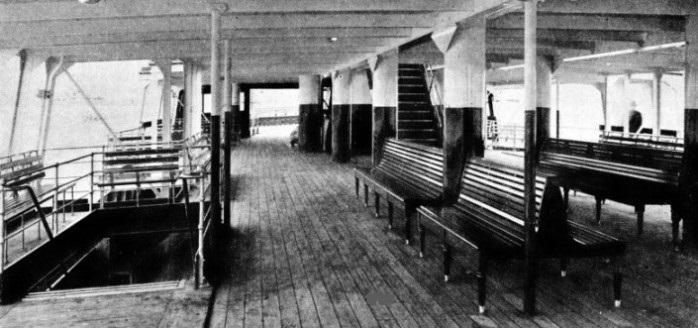
THE PROMENADE DECK of one of the most recent vessels on the Wallasey Corporation ferries. Staircases on either side lead to the main deck and saloons, and amidships to the upper deck. The addition of the third deck in the Royal Iris II and the Royal Daffodil II relieved the congestion on the decks at peak periods. The Wallasey ferries alone carry more than 27,000,090 passengers every year.
No devices have been neglected to insure the Mersey ferries against every possibility of accident. Collision bulkheads are fitted fore and aft on either side, and the vessels closely approach the ideal of the unsinkable ship.
The development of the Birkenhead passenger fleet was similar to that of the Wallasey fleet. The Cheshire of 1864, was followed in 1865 by two smaller but similar vessels, the Lancashire and the Woodside. A second Lancashire and the Claughton, vessels of 469 tons gross, were built in 1899 and were certified to carry more than 1,300 passengers. Four years later followed the new Woodside and the Bidston, vessels of 444 tons gross. In 1910 the Storeton, 342 tons gross, was added, and all these vessels were still in service in 1924.
There, followed in the next ten years a complete revision of the fleet. Of the 1924 vessels only one, the Storeton, remained in 1936. With her speed of 111 knots and 1,075 passengers capacity, she is the slowest and smallest of the present fleet.
The first of the new vessels, the Upton, was built at Birkenhead in 1925. She is certified to carry 1,113 passengers and has a gross tonnage of 374. The Hinderton, 484 tons gross, was built in the same year and carries 1,433 passengers at a speed of 12 knots. Three more vessels, of 487 tons gross, the Bidston, Claughton and Thurstaston, followed in 1930-
Birkenhead is the larger of the two Cheshire boroughs which form part of the Port of Liverpool, and thus her goods ferry is the more important of the two. The first vessels built specifically for carrying vehicles and goods were the Bebington and the Oxton. These vessels, of 435 and 431 tons respectively, entered the service in 1880. Two further vessels of this type were added, the Tranmere in 1884 and the Prenton in 1907.
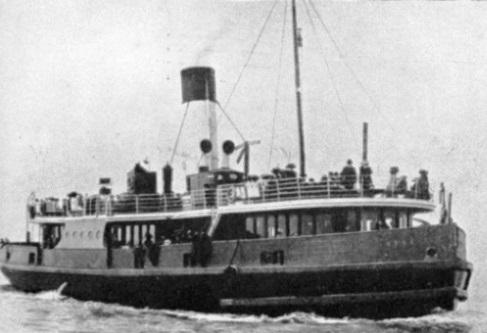
THE PROTOTYPE of the present vessels in the Wallasey Corporation fleet was the Rose, built with her sister, the Lily, at Birkenhead in 1900. The Rose had a gross tonnage of 514. Her length was 155 ft 7 in, her beam 42 ft 1 in and her depth 11 feet. She was sold to act as a tender to transatlantic liners in Queenstown (Cobh) Harbour, Ireland. The present vessels of the Wallasey Corporation and Birkenhead Corporation fleets have many points in common with the Rose, although their design and propelling machinery have been considerably modified and improved.
In 1921 increased traffic necessitated the building of two larger additional vessels, the Barnston and the Churton, of 724 tons gross, at a cost of more than £240,000. The old Oxton and Bebington were replaced in 1925 by new vessels of the same names, having a gross tonnage of 732 and a speed of 10½ knots.
Goods Ferries
The vehicular ferries are of extraordinary shape, being almost rectangular and resembling heavy boxes pushing their way across the swift river. The decks are entirely clear except for a small superstructure round the funnel and a high bridge. The square shape gives the biggest possible carrying capacity for the assorted cargo that these vessels carry across the river.
A crossing in one of the goods ferries is an interesting experience. At Woodside vehicles descend a bridge which leads, at low tide at a considerable gradient, to the floating stage, which is next to the passenger stage. The ship’s officers expeditiously marshal the assorted vehicles which embark across two gangways attached to the vessel. Smaller commercial vehicles and private cars are embarked first. They are backed against bow or stern and packed along the sides, leaving a clear run from port to starboard for a large steam wagon with trailer, which comes on board last of all. The gangways, hinged to the deck, are drawn up, and without a second’s delay the vessel moves off.
The Wallasey vehicular ferries, which ply between Seacombe and Liverpool, are similar in every way. The Leasowe and the Liscard, built in 1921, and the Perch Rock, built in 1929, constituted the fleet in 1936. The first screw vessel appeared in 1881. She was named the Wallasey. The Birkenhead passenger steamer Woodside was bought in 1892. Her decks were cleared and she was renamed Shamrock, but she did not prove a great success on her new service, so the Seacombe, a vessel of 589 tons, was acquired in 1901.
Such are the fleets which keep open all day and all night the highways across the River Mersey. Although since 1934 there has been a magnificent highway under the river, this should not materially affect the passenger traffic. In 1901 the Birkenhead Corporation Ferries carried 9,505,505 passengers. Despite the electrification of the Mersey Railway in 1903 the ferry traffic increased annually, so that by 1920 the figure had reached 16,211,231.
Without the ferries the River Mersey would lose one of its particular characteristics, those fast, sturdy, trim and efficient boats which cross from the Princes Landing Stage to points on the opposite bank with clockwork precision and regularity.
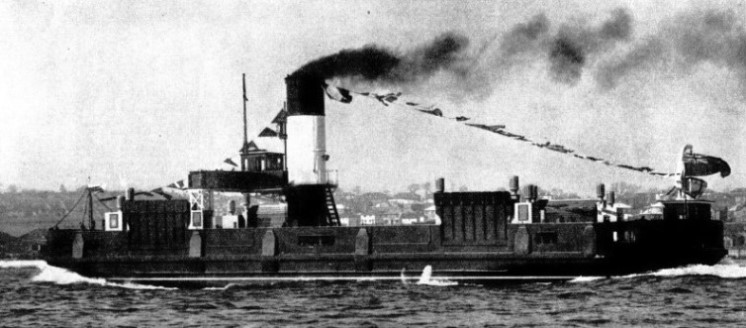
AN UNUSUAL SHIP TYPE designed for the ferrying of vehicles across the Mersey. The latest addition to the Wallasey goods ferry, between Liverpool and Seacombe, is the Perch Rock, a vessel of 766 tons gross, built in 1929. Vessels of this type are almost rectangular in shape, to give the greatest carrying capacity. The decks are entirely clear except for the funnel, and the four gangways are hinged to the deck itself. The Perch Rock is 144 ft. 7 in. long, with a beam of 50 ft. 1 in. and a depth of 15 ft. 5 in.
You can read more on “Coastal Pleasure Steamers”, “Romantic Sailing Coasters” and “Thames Butterfly Boats” on this website.